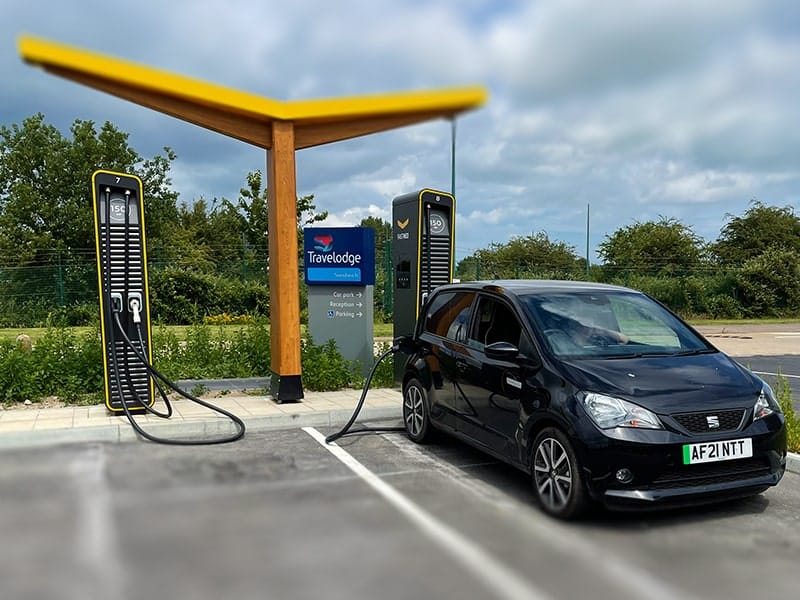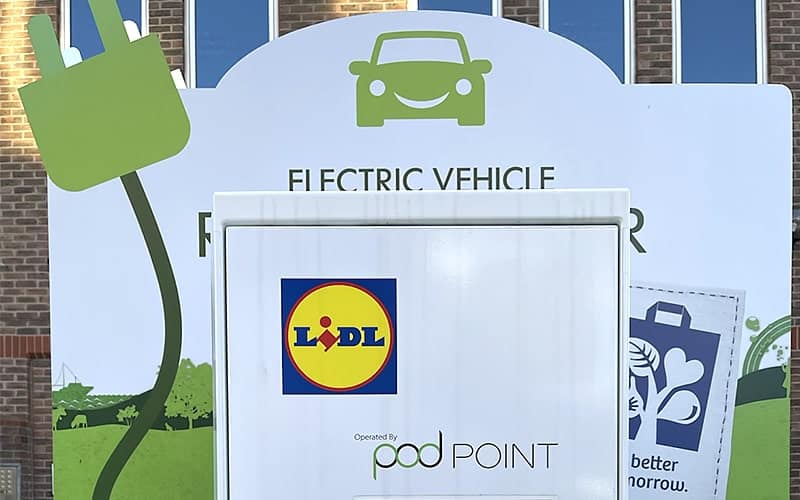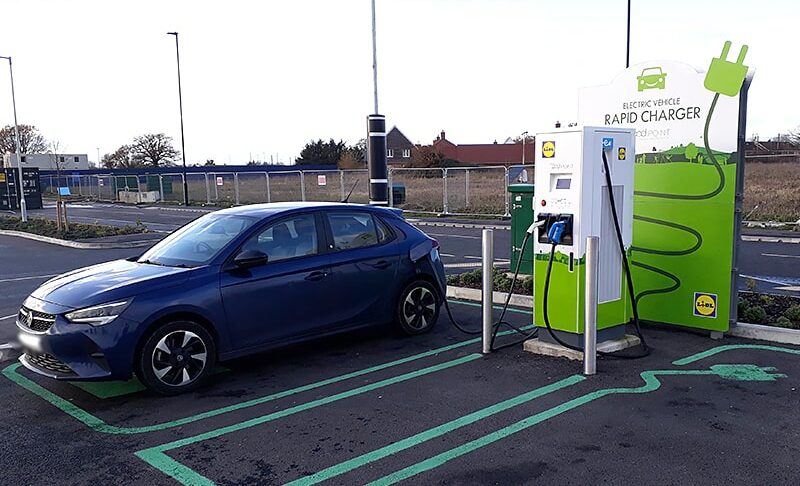
I spent time recently in conversation with representatives from three Charge Point Operators (CPOs) discussing their business models and methodology for choosing locations, charger pricing, and design.
The results were quite eye-opening.
Charge Point Operators have a capital intensive product with very thin margins. So, naturally they’re going to place them in locations which will maximise their return. That’s why the highest concentration of chargers is in London and the lowest is in places like Wales. That’s economics.
Yes, there are EV drivers in mid-Wales who want their cars charged with high power public charging. Yes there are drivers in Ipswich (and Exeter and Cumbria etc.) that all want good public charging.
But there is no magic money tree for chargers just a small investor base, so you want to put the chargers where they’ll get the best use for the invested money.
One of the most used chargers on the UK network deals with 30 charges per day.
Conversely, checking Zap Map indicates that there are chargers from the same network in places like Wiltshire and Devon that get used once every couple of days.
The places we need chargers built are either places where they already exist but are constantly busy, or they are in less populated, or quieter, places where there aren’t many chargers but when they’re needed they have to work and be reliable.
So that’s the dilemma the CPOs are faced with: Spend lots of money putting chargers in where the demand is there but not great, or spend the same money putting chargers in where there’s lots of demand.
Instavolt recently added an extra eight chargers to the Banbury hub to go with the existing eight chargers. The demand is there and it can be justified. These chargers are two minutes drive away from an Osprey Hub and only a short drive from Cherwell Valley services which has a couple of Gridserve units.
Siting chargers is more art than science, though. It’s not a case of finding a car park, throwing up a small substation and a couple of ABB chargers and marking the bays out for EV charging. It’s much more complicated. You need landlords willing to provide the space, DNOs willing to provide the power supply, councils willing to grant planning permission for the install, and lots of money to put these in.
I spoke with Fastned recently about the new hub they were involved in installing at the Redbridge Park and Ride in Oxford. Nobody would reveal the cost for the Oxford Superhub where they installed their 5 Alpitronic units. But consider that an Alpitronic 350 kW charger retails at around €87,000 euros for the basic 350kW unit alone. I’m led to believe that Fastned didn’t pay full retail price for them, though. This doesn’t include the foundations, the power cabinets, the canopy, the Tesla Units, the signage or anything else.
That’s a big financial gamble for CPOs.
So the CPOs each approach locations in a different way.
Tom Hurst (UK country manager and network development manager at Fastned) told me that they look for locations which are in high traffic areas with lots of space so they can build their canopies. Podpoint look primarily for locations suited to slower charging with the companies they have partnerships with such as Tesco and Aldi. Geniepoint are similar with Morrisons and Whitbread but with mainly rapid chargers.

James McKemey (Head of policy and public affairs at Podpoint) made an interesting comment when I asked them about the service provision in one of the infamous Charging Wastelands of Mid Wales:
“If you look at the population density of Wales and indeed the way people travel around Wales, South and North Wales, the transit seems to be quite lateral. There isn’t really a lot that goes North/ South and the population density in the middle of Wales obviously is very low and as a result it can be a slightly less compelling place to invest in charging infrastructure.”

Recently there have been a number of CPOs with extremely poor reliability at their chargers. Geniepoint is one of these. I asked Dee Humphries, CEO of Equans EV the – company that owns the Geniepoint network – about this. She told me:
“I think it’s fair to say that I share the frustrations that our drivers have and we’re not doing well enough… last year we had problems where the charger is working but the back office wasn’t good enough and used to fall over all the time which meant that whilst the charger was fine you can’t actually start it, though we fixed that by moving over to AWS… however we’ve had significant delays sourcing new charger hardware.”
Brexit played a part in that, as did the pandemic. But Dee also said:
“I know it’s not big numbers but I believe we’ve fixed seven chargers in the last week and will carry on about that rate. So we will continue to ramp that rate up, but it will be a minimum seven a week that get fixed.”
A couple of things that come out of that: seven chargers upgraded per week, minimum, will mean the whole Geniepoint network (500 rapid charging points) will be upgraded in about 18 months, maximum. Furthermore, Geniepoint are moving to a new hardware supplier meaning new installs should be a lot more reliable than in the past. Their recent multi-unit hub at Little Clacton, for example, uses Alpitronic hardware for their rapid chargers.
Charger design is now something to which CPOs are paying a lot more attention. Public charging started as a novelty activity, something a couple of people do. It’s now grown into a huge business. I think there’s a case to say a lot of CPOs are running in ‘catch-up’ mode when it comes to providing what is needed now vs. what was needed when charging was a very niche activity for Zoes, Leafs and iMievs.
For example, the vast majority of the UK chargers are ‘front in’ or ‘rear in’ parking bays where you drive into a slot and jut up against a bumper of some sort. It’s very much a legacy of the sort of cars we started with as the Leafs and Zoes all had chargers located at the front of the car.
But we’re now getting to the stage where more and more last mile delivery vans are going electric. What this is doing is bringing larger and longer vehicles into the charging mix. Also vehicles with trailers or caravans attached to them. Drive-in charging is impractical in that situation and the preferred solution is ‘drive through’ charging – similar to what we do at petrol stations at the moment.
Aligned with this is the whole area of accessibility and safety. Chargesafe has recently signed deals with Osprey Charging and 3ti to provide accessibility and safety ratings for all its chargers aligned with the draft PAS1899 standard from the BSI on charger design. Luckily Fastned, Podpoint and Geniepoint all recognise that this is an issue and are looking to make improvements wherever they can.
On the continent Fastned have specific design cues which aid safety and accessibility, as well as having the ‘drive-through’ design rather than the ‘drive in’ design. In several of their existing UK chargers this is still the case. The Oxford Superhub originally started as a drive-through design but space issues – added to the potential loss of parking revenue to the council through losing more parking slots – meant they ended up moving back to the drive in design. That’s a shame.
Podpoint are already on the PAS1899 steering group and are helping shape that standard. Geniepoint acknowledge that it’s important they get this right and they’re making the right moves at the moment. The realise, for example, that their existing set-up usually mandates two parking bays for a rapid charger where, in reality, three per charger is the optimum number. They’re also looking at things such as the bump stops being a different size to improve spacing, as well as ensuring chargers are not situated up a step from the ground, and screens are easier to read from all angles.
There’s still a way to go with this but with organisations such as Chargesafe helping to pave the way, safety and accessibility should start to become important factors for charger design and installation.
Motorway service areas are also an important area of discussion for the CPOs. Following the recent CMA ruling against Gridserve shortening their monopoly at many MSAs this opens the door for other operators to come in and provide charging at these sites. At the moment, Tesla are in at some MSAs, Instavolt are in one, bp Pulse have installed (but not commissioned) chargers at several bp fuel stations in MSAs, and Welcome Break appear to want to do their own thing having installed Applegreen units at both South Mimms and Hartshead Moor Services. Of course Ionity have a presence at a number of MSAs and, under the terms of their agreement, Gridserve have to throttle their chargers at those sites to 60kW maximum charge speed.
In an ideal world – at least in my mind – every MSA would have Osprey, Instavolt, Fastned, Podpoint etc. chargers all lined up. This provides redundancy, scaling and competition.
Unsurprisingly the CPOs don’t see it like that. Geniepoint are not looking at MSAs just now, it doesn’t fit their business model. But Fastned and Podpoint definitely are.
However they want exclusivity. The idea of having to capacity plan – and investment plan – on a site where there might be numerous competing CPOs sends shivers down the back of companies like Fastned and Podpoint
Regarding MSA charging installs themselves, James from Pod Point told me:
“We aren’t particularly enamoured with the way that’s been set up at the moment… Our vision, if you were to get towards perfection, would be to give individual charge point operators exclusivity per motorway service area but ensure that no provider is owning the neighbouring one as well.”
I don’t know whether I personally subscribe to this approach. If I’m at an MSA I want as many available chargers as possible with a range of prices. Giving them all to one company at one site means there’s the possibility of price gouging (I mean it happens with the petrol stations at MSAs, why would charging be any different?) James McKemey is of the opinion that if the price is high at a given MSA you can always go to the next one which will have a different provider.
All of which leads us very nicely onto the topic of pricing. The ability of a CPO to determine the price per kWh for a charge is the key to them being profitable. In the four years since I started driving EVs the price has gone from a low of around 11p/ kWh (with subscription) to a current price in excess of 60p/kWh without subscription at some of the highest rated CPOs. Fastned charge 54p/ kWh, Geniepoint charge 57p/kWh. Fastned are not yet profitable at that rate given the low number of chargers and charges they have in the UK at the moment. But that price gives them a chance of profitability over the long run. I’ve had similar conversations with other CPOs in the past. Geniepoint just about make money at that rate. Dee Humphries did tell me, however, that they make less profit per kWh at that price than they did when wholesale electricity was cheaper and their price per kWh was lower.
It’s worth remembering, too, that Dee is, I believe, the only major executive at a charge point operator who both doesn’t have a home charger – so has to charge using her own public network – and pays full price for charging rather than taking the employee discount offered by her company. So when she says the decision to raise prices was a painful one she means that on a personal level.
The good news from a pricing perspective is that when the wholesale electricity price drops it is expected that retail prices will drop as well, although there may well be a lag as many CPOs bulk buy energy in advance and have to wait until that contract has expired before buying in at a lower rate. That’s when the lower prices will filter down.
Overall the CPOs have a very fine balancing act to try and achieve. They want as many chargers out in the wild as possible. They realise the market is expanding and more infrastructure is needed. But every site costs money – lots of money. So they need to make sure the pricing allows them to make money on each charge while also staying low enough to ensure drivers aren’t annoyed when the price of charging starts to approach the price of fossil fuels per mile. They also need to stay competitively priced with rivals who might have different pricing models.
From a driver’s side we all want lots of reliable, multi-unit charging locations with high power chargers and lots of redundancy. But we don’t want to pay high charging costs for them.
That’s the dilemma.
The complete discussion with the CPOs can be found here.
About the author
Gary hosts the EV Musings Podcast – a podcast about renewables, electric vehicles and things that are interesting to electric vehicle owners. He is an EV driver of four years and an advocate for renewables. He can be reached at evmusings@gmail.com and his podcast is at evmusings.libsyn.com






